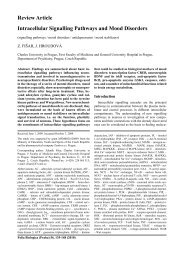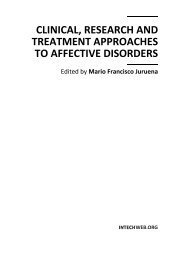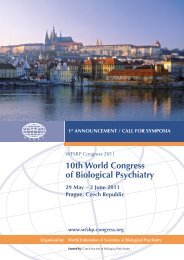MOOD DISORDERS
MOOD DISORDERS
MOOD DISORDERS
Create successful ePaper yourself
Turn your PDF publications into a flip-book with our unique Google optimized e-Paper software.
66<br />
Mood Disorders<br />
These symptoms cause clinically significant impairments in the social, occupational or other<br />
fields of life in the most frequent cases, and cannot be explained by the direct effect of phar‐<br />
macological treatment, substance abuse, another disease or simple sorrow.<br />
5. Brief history of CBT<br />
In the 1950s, psychology as a scientific theory and practice underwent a major development.<br />
During this period, the first steps of behavioral therapy (BT) were developed independently<br />
in the USA and in England based on the knowledge gained in experimental psychology and<br />
subsequently developed learning theories. Right from the beginning, BT was a collective<br />
term for a variety of different therapeutic procedures. The common feature of these proce‐<br />
dures is that, unlike personality, behavior - including cognitive, emotional and physical re‐<br />
sponses - can be built, reduced and modified during the lifetime of the individual [75].<br />
The roots of cognitive BT and behavioral learning theories go back to ancient times. Epicte‐<br />
tus, a Greek stoic philosopher, who is considered one of the major influences in the develop‐<br />
ment of psychotherapy, wrote: "Men are disturbed, not by things, but by the principles and<br />
notions which they form concerning things". Freud (1900/1953) was the first modern-day sci‐<br />
entist addressing the perception that symptoms and feelings are based on unconscious<br />
thoughts. Alfred Adler [76], who was an important proponent of individual psychology,<br />
noted that humans actually do not suffer from an experienced trauma, but rather from the<br />
perception of personal interpretation of the event. In the beginning of the 19 th century, the<br />
phenomenological direction of philosophy had a great impact on the development of psy‐<br />
chology and the maturation of CBT, as authors including Kant, Heidegger and Husserl es‐<br />
tablished their theory on the control of conscious experiences [77].<br />
The principal element of CBT, classical conditioning, is a behavioral learning theory found‐<br />
ed by Russian physiologist I. P. Pavlov (1849-1936), stating that new and conditioned reflex‐<br />
es can be added to natural, mostly inherited, unconditioned reflexes by means of learning.<br />
Based on the knowledge of classical conditioning it is also possible to generalize or erase be‐<br />
havioral patterns [78]. John B. Watson, who is considered to be the founder of classical be‐<br />
haviorism, described mental processes, e.g. thoughts, as responses to the autonomic nervous<br />
system on external stimuli, and he attempted to explain behavior on the basis of conditioned<br />
reflexes described by Pavlov. He wrote: "Give me a dozen healthy infants and I will train them to<br />
become any type of specialist I might select" [79].<br />
Contrary to classical conditioning, operant conditioning theory stated that spontaneous<br />
behavior is promoted or inhibited by the consequence that follows. In the 1950s, Burrhus<br />
Frederic Skinner further developed the concept of operant or instrumental conditioning.<br />
Skinner's approach was to positively or negatively impact behavior by means of subse‐<br />
quent consequences. Based on this theory, behavior is supported by positive consequen‐<br />
ces, while negative consequences result in reduction or deletion of certain behavioral<br />
elements. This concept corresponds to an S-R-C model, with a stimulus (S) followed by<br />
the response (R), and the consequences (C). The S-R-C model is considered to be one of






